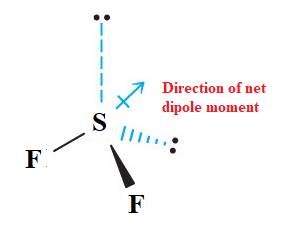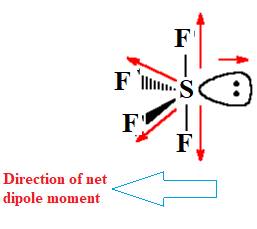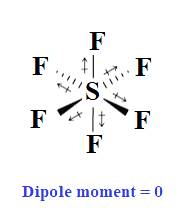
Concept explainers
Use Lewis structures to predict the molecular polarities for sulfur difluoride, sulfue tetrafluoride, and sulfur hexafluoride.
Interpretation:
The molecular polarities for sulfur difluoride, sulfur tetrafluoride, and sulfur hexafluoride are to be determined.
Concept introduction:
The asymmetric structure and presence of polar covalent bonds confirms that the molecule is polar in nature. The molecule having some dipole moment is termed as polar molecule and the molecule with no dipole moment or zero dipole moment is identified as nonpolar molecule.
Answer to Problem 123A
The sulfur difluoride and sulfur tetrafluoride are polar, but sulfur hexafluoride is nonpolar.
Explanation of Solution
The given molecule sulfur difluoride

In
The given molecule sulfur tetrafluoride

In
The given molecule sulfur hexafluoride

In
The sulfur difluoride and sulfur tetrafluoride are polar but sulfur hexafluoride is nonpolar.
Chapter 8 Solutions
Glencoe Chemistry: Matter and Change, Student Edition
Additional Science Textbook Solutions
Organic Chemistry
Chemistry: The Central Science (14th Edition)
Chemistry: The Central Science (13th Edition)
Chemistry: A Molecular Approach
Chemistry: Structure and Properties (2nd Edition)
Chemistry: Structure and Properties
 ChemistryChemistryISBN:9781305957404Author:Steven S. Zumdahl, Susan A. Zumdahl, Donald J. DeCostePublisher:Cengage Learning
ChemistryChemistryISBN:9781305957404Author:Steven S. Zumdahl, Susan A. Zumdahl, Donald J. DeCostePublisher:Cengage Learning ChemistryChemistryISBN:9781259911156Author:Raymond Chang Dr., Jason Overby ProfessorPublisher:McGraw-Hill Education
ChemistryChemistryISBN:9781259911156Author:Raymond Chang Dr., Jason Overby ProfessorPublisher:McGraw-Hill Education Principles of Instrumental AnalysisChemistryISBN:9781305577213Author:Douglas A. Skoog, F. James Holler, Stanley R. CrouchPublisher:Cengage Learning
Principles of Instrumental AnalysisChemistryISBN:9781305577213Author:Douglas A. Skoog, F. James Holler, Stanley R. CrouchPublisher:Cengage Learning Organic ChemistryChemistryISBN:9780078021558Author:Janice Gorzynski Smith Dr.Publisher:McGraw-Hill Education
Organic ChemistryChemistryISBN:9780078021558Author:Janice Gorzynski Smith Dr.Publisher:McGraw-Hill Education Chemistry: Principles and ReactionsChemistryISBN:9781305079373Author:William L. Masterton, Cecile N. HurleyPublisher:Cengage Learning
Chemistry: Principles and ReactionsChemistryISBN:9781305079373Author:William L. Masterton, Cecile N. HurleyPublisher:Cengage Learning Elementary Principles of Chemical Processes, Bind...ChemistryISBN:9781118431221Author:Richard M. Felder, Ronald W. Rousseau, Lisa G. BullardPublisher:WILEY
Elementary Principles of Chemical Processes, Bind...ChemistryISBN:9781118431221Author:Richard M. Felder, Ronald W. Rousseau, Lisa G. BullardPublisher:WILEY





